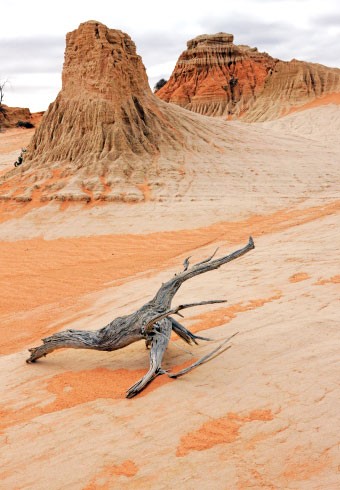Back
Mungo National Park & Lunette
芒戈国家公园与月牙形低丘

a lunette is a single, massive dune ridge formed from clay and sand blown up from the lake
月牙形低丘是湖中吹出的粘土和沙子堆积而成的单个巨大沙丘脊
月牙形低丘是湖中吹出的粘土和沙子堆积而成的单个巨大沙丘脊
Mungo National Park includes Lake Mungo an ancient dry lakebed. During the last ice age, Lake Mungo was one of a chain of freshwater lakes strung along the Willandra Creek.
As the Australian continent slowly drifted northwards into hotter, drier climes, temperature and climatic conditions continued to change. About 400,000 years ago dry, windy conditions prevailed and the sluggish, meandering Willandra Creek was cut off, forming the Willandra Lake system. Over time the westerly winds shaped the lake and, as the water receded, continued to shape and create a lunette. The lunette consists of layer upon layer of sand and silt deposited over tens of thousands of years.
芒戈湖其实是一个古老的干涸湖床,位于芒戈国家公园内部。在上一个冰河时期,芒戈湖还是一个淡水湖,坐落在威兰德拉河沿岸。
随着澳大利亚大陆向更热、更干燥的北方气候区缓慢漂移,整个区域的温度和气候也在不断变化。大约40万年前,干旱的风季导致缓慢蜿蜒的威兰德河渐渐断流,形成了威兰德湖系统。随着时间的推移,湖泊的形状在西风的作用下发生变化,伴随着水位的下降,湖泊渐渐形成了一个月牙形低丘。月牙形低丘由一层又一层的砂和淤泥堆积而成,沉积时间长达数万年。

